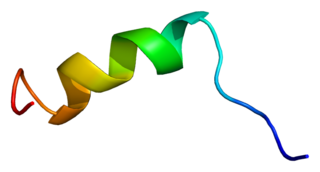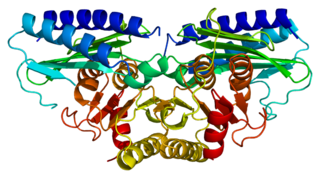
Protein kinase C beta type is an enzyme that in humans is encoded by the PRKCB gene.

G protein-coupled receptor 50 is a protein which in humans is encoded by the GPR50 gene.

Sodium channel protein type 2 subunit alpha , is a protein that in humans is encoded by the SCN2A gene. Functional sodium channels contain an ion conductive alpha subunit and one or more regulatory beta subunits. Sodium channels which contain sodium channel protein type 2 subunit alpha are sometimes called Nav1.2 channels.

SH3 and multiple ankyrin repeat domains protein 2 is a protein that in humans is encoded by the SHANK2 gene. Two alternative splice variants, encoding distinct isoforms, are reported. Additional splice variants exist but their full-length nature has not been determined.

Inositol monophosphatase 2 is a 32 kDa enzyme that in humans is encoded by the IMPA2 gene. IMPA2 dephosphorylates myo-inositol monophosphate to myo-inositol.

Dyslexia susceptibility 1 candidate gene 1 protein is a protein that in humans is encoded by the DYX1C1 gene. This protein contains 420-amino acids with 3 tetratricopeptide repeat (TPR) domains, thought to mediate protein–protein interactions.

KN motif and ankyrin repeat domain-containing protein 2 is a protein that in humans is encoded by the KANK2 gene.

Ankyrin repeat domain-containing protein 17 is a protein that in humans is encoded by the ANKRD17 gene.

KN motif and ankyrin repeat domain-containing protein 1 is a protein that in humans is encoded by the KANK1 gene.

Ankyrin repeat and SOCS box protein 3 is a protein that in humans is encoded by the ASB3 gene.

Ankyrin repeat domain-containing protein 23 is a protein that in humans is encoded by the ANKRD23 gene.

Ankyrin repeat and BTB/POZ domain-containing protein 1 is a protein that in humans is encoded by the ABTB1 gene.

Ankyrin repeat, SAM and basic leucine zipper domain-containing protein 1 is a protein that in humans is encoded by the ASZ1 gene.

Ankyrin repeat and SOCS box protein 6 is a protein that in humans is encoded by the ASB6 gene.

Ankyrin-3 (ANK-3), also known as ankyrin-G, is a protein from ankyrin family that in humans is encoded by the ANK3 gene.

Protocadherin Fat 4, also known as cadherin family member 14 (CDHF14) or FAT tumor suppressor homolog 4 (FAT4), is a protein that in humans is encoded by the FAT4 gene.

WD repeat-containing protein 72 is a protein that in humans is encoded by the WDR72 gene. WDR72 contains 7 WD40 repeats, which are predicted to form the blades of a 7 beta propeller structure.

HORMA domain containing 2 is a protein that in humans is encoded by the HORMAD2 gene.

Family with sequence similarity 155, member A is a protein that in humans is encoded by the FAM155A gene.

Mab-21 like 1 is a protein that in humans is encoded by the MAB21L1 gene.


















